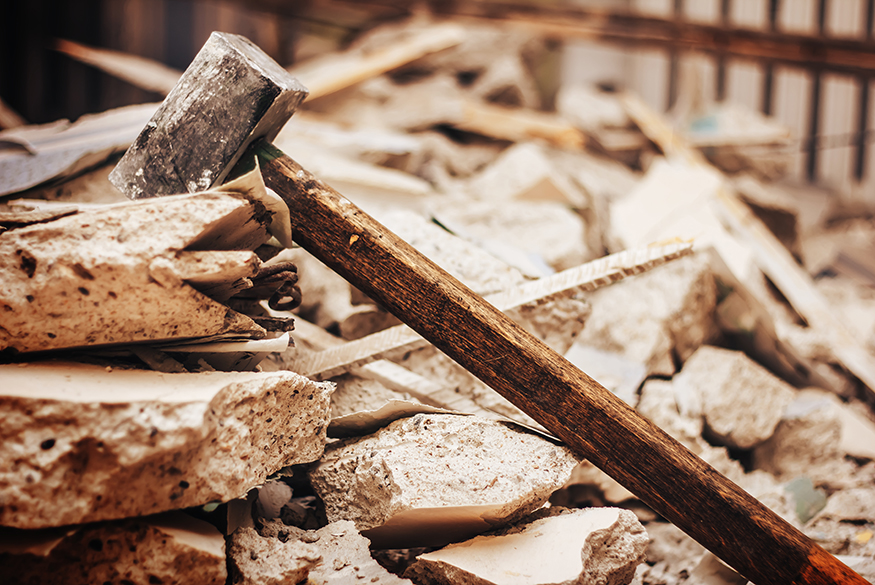Demolition Recovery
Recovering Construction Waste During a Tenant Build-Out
Build-outs produce a lot of waste. That’s unavoidable. But that doesn’t mean that you have to be wasteful with your waste. Demolition Recovery, or recovering, recycling or reusing waste materials during a tenant build-out allows building owners and managers to save money and resources, all while helping to protect the environment.
WHAT IS WASTE RECOVERY
Waste recovery refers to the sustainable practice of reusing or recycling materials during construction or demolition. Reuse includes the deconstruction and salvaging of construction and demolition (C&D) materials. In deconstruction, these materials are identified and carefully removed prior to demolition. For instance light fixtures or wooden beams may be removed from the ceilings and walls. Some choose to deconstruct the entire site instead of using demolition while others use a combination of the two.
Salvaging is the use and saving of reusable items such as doors and hardware. After deconstructing or salvaging materials, you may then choose to reuse them in the current project or sell or donate them to reuse markets.
Recycling C&D waste involves diverting recyclable waste from landfills and sending them to facilities for processing. Materials like lumber, concrete, and metal are often recycled.
WHY SHOULD YOU RECOVER YOUR C&D WASTE?
There is a misconception that the process of recycling or salvaging waste is too expensive or time-consuming to pursue. The truth is, however, that recovering C&D waste can cut costs. More recovery means lower landfill fees. And haulers typically charge less for recycling than for trash collection. When you divert waste from trash to recycling, you reduce your trash bin size, meaning fewer weekly collections. And while sorting the debris takes more time, this expense is lower than landfill fees. Committing to a C&D waste recovery initiative can also improve your organization’s sustainability and public image, and you can even get LEED credits for your efforts (see below).
And, of course, recovering C&D waste protects and preserves natural resources. When you decide to recycle or reuse C&D waste, you are reducing the need for trees, metals, and water to be extracted from the environment. Not to mention, less energy is required to make the same products from recycled materials than from virgin material, thus lowering levels of pollution. To gain these benefits and contribute to preserving resources, you’ll first need a waste management plan.
DESIGNING A WASTE RECOVERY PLAN
There are many aspects involved in C&D waste recovery during a build-out. Designing a waste management plan early-on, before the build-out project begins, can help to facilitate the process and allow the endeavor to run more smoothly. Be sure to consider the following factors when developing your plan:
Goals and Tracking
Before getting started, you should decide what your objectives are and how you will measure the success of your goals. Identify the materials you will recover and specify a minimum diversion rate based on either weight or volume.
Tracking your progress will help you to not only stay organized during the process but can also enable you to share and report information to stakeholders. Keep records of your recovery efforts in one platform using a standard set of metrics. There are several online tools to help such as Energy Star Portfolio Manager. The EPA has information on these tools as well as worksheets and tips for managing your tracking as well.
Education and Training
Appointing a waste recovery supervisor can help keep everyone on the same page. Hiring contractors familiar with C&D recovery can aid in the ease of the recovery process, and educating and training all workers can help to avoid mishaps such as contamination of recycling bins and improper sorting of materials.
Space
Particularly in a build-out, space should be a consideration when making your recovery plan. You will likely need room for recycling bins as well as locations for collecting reusable materials.
Materials
Before you begin recovering waste, you must determine which materials you will collect. Materials suitable for reuse — for deconstruction and salvage — include plumbing fixtures, doors, windows, ceiling and floor tiles, decorative items, and cabinets. Carefully remove these items prior to demolition.
If intending to recycle C&D waste, you can work with your hauler, recycler, or contractor to determine which materials are recyclable. Recyclable materials typically include metal, lumber, corrugated cardboard, and wallboard. Sort these materials by type using labeled bins. Make sure to clearly mark this bins so that trash doesn’t accidentally get thrown in. Even a small amount of trash in one of these bins can prevent the load from being approved for recycling.
Additionally, be aware of materials that cannot be recycled and of those that may be contaminated. Waste containing asbestos or lead, for instance, requires specialized handling and decontamination procedures.
Markets for salvaged materials
If you choose not to reuse materials for your own projects, there are markets available that will take the reusable materials. Some organizations that accept these reusables include the Habitat for Humanity ReStore and the Lifecycle Building Center. Check your local area for salvage vendors, liquidators, materials brokers, and reuse retailers for more options.
Recycling services
There are recycling services available that offer curbside pick-up of recycled materials. Note that curbside pick-up is a more environmentally friendly option than transporting the recycled materials to the recycling plant. Again, check your local listings for recycling services in your area.
WASTE RECOVERY AND LEED
You can get LEED credits for your waste recovery efforts as well. For instance, you can earn a point for solid waste management if you follow their guidelines. These include requirements such as reusing or recycling 50% of the ongoing consumables waste stream and maintaining a waste recovery program that addresses durable goods. See their website for more information.
MASTERFORMAT INTRODUCES NEW CODES FOR WASTE RECOVERY
MasterFormat 2018 has recently released an expansion of codes to aid in recovery efforts. These codes provide specifications for the recycling and salvaging of materials to identify, manage, and divert C&D waste. Included in this change is a new trade for a Deconstruction Contractor. The Deconstruction Contractor will be the first in to remove recovered materials prior to demolition. They can be trained and certified by the Building Materials Reuse Association. See here for more information.
Waste recovery is a admirable endeavor than can have a positive and lasting impact on our environment. Reusing and recycling waste not only helps owners and managers save money but also protects our most precious natural resources.
Sources
“Recover Your Resources.” EPA,
https://www.epa.gov/sites/production/files/2015-09/documents/cdbrochure.pdf
Stamper, Stacie. “Construction and Demolition Waste: the Final Frontier.” Grapevine Wall. http://grapevinewall.com/wp-content/uploads/2018/01/EPA_MasterformatCall.pdf
“Solid waste management.” USGBC, https://www.usgbc.org/credits/mr21
“Managing and Reducing Wastes: A Guide for Commercial Buildings.” EPA, https://www.epa.gov/smm/managing-and-reducing-wastes-guide-commercial-buildings
“Construction and Demolition Recycling Guide.” San Diego County, https://www.sandiegocounty.gov/dpw/recycling/Files/Construction_Guide_SJ8_Pgs_1-27.pdf









